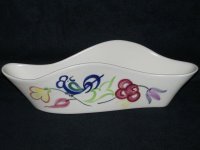How old is my cockerel?
At the Thurrock Antiques Fair last week another stallholder asked me about two Poole Pottery jugs she had bought on e-bay. They had a traditional floral pattern featuring a blue cockerel and she had been told they were 1940's and worth over £100 each. The jugs were nice enough but unfortunately much more recent than the 1940's, carrying the backstamp for 1967 - 1972, and perhaps worth £25 - £30 retail.
The cockerel pattern is traditional design LE, which originally dates from Truda Carter in the 1930's. However, along with patterns BN and CS, it was produced well into the 1970's and so there is plenty of room for confusion with dating.
The designs did change over the years though, and it is fairly easy to spot the differences and date the pieces approximately without reference to backstamps and paintress marks. Essentially, the older the piece the more finely painted it will be.
It is worth noting that before the 1950's there was a much larger range of floral patterns, so it is much less common to see a 1930's / 40's LE pattern. If you do, most Poole Pottery from the 1930's shows its age - it is likely to have at least fine crazing. In the LE pattern the birds are very detailed, and the blue bird (cockerel) has 5 tail feathers in the examples I have seen.
 In 1951 the floral ranges were standardised and simplified by Ruth Pavely. The bluebird in the LE pattern is now much less detailed, but still retains a yellow highlight. Most examples have 4 tail feathers.
In 1951 the floral ranges were standardised and simplified by Ruth Pavely. The bluebird in the LE pattern is now much less detailed, but still retains a yellow highlight. Most examples have 4 tail feathers.
The flowers are also less detailed, petals delimited with a single line rather than a subtle graduation of colour, for example.
 In 1963 the designs were simplified again. In this case the LE bluebird is drawn with just a few brushstrokes, and probably has only 2 or 3 tail feathers. The flowers have fewer petals and even less delineation. The only confusion in dating is that the 1951 design was still produced as an elaborate version ("E/LE").
In 1963 the designs were simplified again. In this case the LE bluebird is drawn with just a few brushstrokes, and probably has only 2 or 3 tail feathers. The flowers have fewer petals and even less delineation. The only confusion in dating is that the 1951 design was still produced as an elaborate version ("E/LE").
So, as soon as you see the very simple bluebird (or flowers on other patterns) you know you're looking at a piece of '60's or '70's worth rather less than a finely drawn 1930's piece. I hope the stallholder hadn't paid too much!
The cockerel pattern is traditional design LE, which originally dates from Truda Carter in the 1930's. However, along with patterns BN and CS, it was produced well into the 1970's and so there is plenty of room for confusion with dating.
The designs did change over the years though, and it is fairly easy to spot the differences and date the pieces approximately without reference to backstamps and paintress marks. Essentially, the older the piece the more finely painted it will be.
It is worth noting that before the 1950's there was a much larger range of floral patterns, so it is much less common to see a 1930's / 40's LE pattern. If you do, most Poole Pottery from the 1930's shows its age - it is likely to have at least fine crazing. In the LE pattern the birds are very detailed, and the blue bird (cockerel) has 5 tail feathers in the examples I have seen.
 In 1951 the floral ranges were standardised and simplified by Ruth Pavely. The bluebird in the LE pattern is now much less detailed, but still retains a yellow highlight. Most examples have 4 tail feathers.
In 1951 the floral ranges were standardised and simplified by Ruth Pavely. The bluebird in the LE pattern is now much less detailed, but still retains a yellow highlight. Most examples have 4 tail feathers.The flowers are also less detailed, petals delimited with a single line rather than a subtle graduation of colour, for example.
 In 1963 the designs were simplified again. In this case the LE bluebird is drawn with just a few brushstrokes, and probably has only 2 or 3 tail feathers. The flowers have fewer petals and even less delineation. The only confusion in dating is that the 1951 design was still produced as an elaborate version ("E/LE").
In 1963 the designs were simplified again. In this case the LE bluebird is drawn with just a few brushstrokes, and probably has only 2 or 3 tail feathers. The flowers have fewer petals and even less delineation. The only confusion in dating is that the 1951 design was still produced as an elaborate version ("E/LE").So, as soon as you see the very simple bluebird (or flowers on other patterns) you know you're looking at a piece of '60's or '70's worth rather less than a finely drawn 1930's piece. I hope the stallholder hadn't paid too much!
